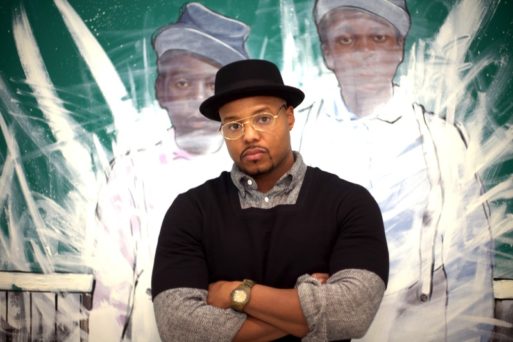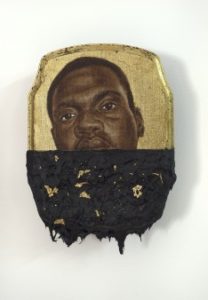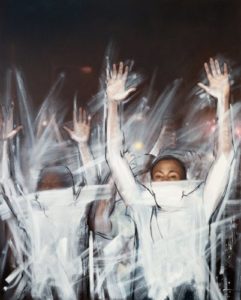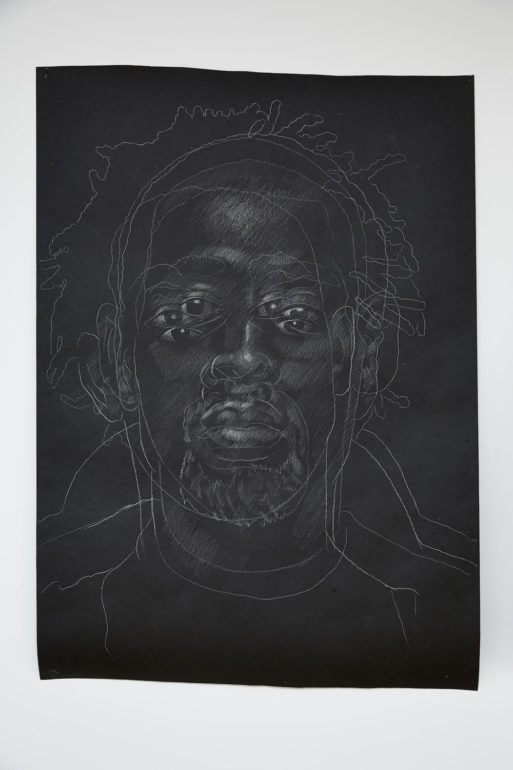
Credit: artslant.com
Titus Kaphar was born in Kalamazoo, Michigan in 1976. He graduated with a master’s degree in fine arts from the Yale School of Art. He describes his artistic style as a combination of Classic and Renaissance. Kaphar works with many mediums, including tar, chalk and cement paper. He sometimes uses blades to slash his paintings or drapes part of his work so the viewer can only see a glimpse of what is going on.
As part of his studies, Titus Kaphar developed an interest in history. When asked about what had learned during an interview with Vice, he said, “I feel very strongly that most of the history that we have been taught is at best incomplete and at worse fiction.”
Exploring Black History

Credit: studiomuseum.org
Kaphar was acutely aware that black men and women had been silenced throughout American history so that their stories were never accurately told. To reflect this, he created a series of drawings of black men with tar poured over their lower faces –the tar figuratively “silencing” them.
He later became interested in his father, whom he had not seen in many years and with whom he does not share a last name. He eventually found him online and learned that he was incarcerated, as were several other black men with the same last name. Kaphar began to research how the penal system treats people of color. He soon realized that black men were more likely to be sentenced to jail than white men who had committed the same crime.

Credit: saltermcneil.co
Kaphar was also deeply troubled by the acquittal of police officer Darren Wilson. Wilson was charged with the fatal shooting of Michael Brown in Ferguson, Missouri, in 2014. Brown, who was black, was unarmed at the time. Kaphar did some research and discovered that Brown’s killing was not an isolated incident. Several other young black men, including Trayvon Martin, had shared the same fate. (Martin, an unarmed teenager, was shot by George Zimmerman, a neighborhood watch commander. Zimmerman, who used Florida’s “Stand Your Ground” law as a defense, was acquited of the crime.)
Titus Kaphar began to collect pictures of unarmed black men who had been killed during contact with the police. He then created various pieces of art that depicted their fate. One picture shows black men with their arms raised in surrender. (Some witnesses claimed that Michael Brown had his hands in the air when Wilson shot him. However, the Justice Department later said this was probably not true.)
Perhaps Kaphar’s most moving work is a “portrait” he drew with chalk on cement paper. It shows images of black men who were killed by the police superimposed upon each other so that it is impossible to see any of the faces clearly. They seem to blend into one another, just as black men seem to merge into a single entity in the eyes of the criminal justice system and the police.

Credit: vice.com
Titus Kaphar is an important artist because of he is willing to tackle subjects that many people shy away from. It’s virtually impossible to look at his work without experiencing strong emotions about justice and injustice, and life and death.
If you would like to see more of Titus Kaphar’s work, check out his exhibits online at the Jack Shainman Gallery.

 Titus Kaphar and His Compelling Views of Death and Racism
Titus Kaphar and His Compelling Views of Death and Racism


 Debating Medical Aid in Dying
Debating Medical Aid in Dying
 “Help Me, Helen”
“Help Me, Helen”















